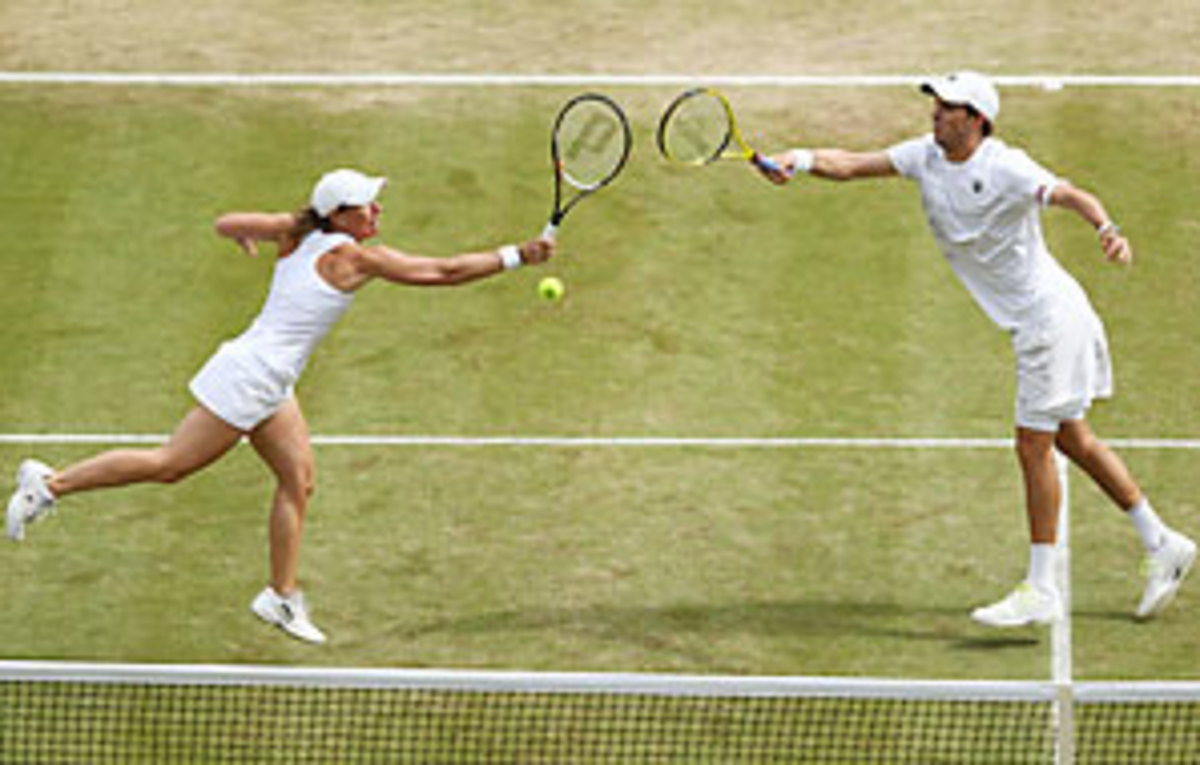Olympic mixed doubles debut taps into one of tennis' greatest virtues


These Olympics, we are continually told, are the "Women's Games." Jacques Rogge, the IOC head, has asserted (and reasserted) that, for the first time ever, every participating country is represented by at least one woman. In the case of the U.S. delegation, women outnumber the men. The television coverage has made a conscious and conspicuous effort -- with varying degrees of success -- to balance the coverage between genders.
In the Kingdom of Tennis this all seems almost quaint. This is a sport that, for all its resistance to change, is often a beacon of progressivism. The game can -- and does -- quibble over how to split revenues. But providing an equal platform to men and women is second nature. There's an LPGA Tour, but the women never play the Masters. Friends who are diehard NBA fans couldn't name two WNBA teams under threat of tasering.
In tennis? Men and women competing together is second nature. And fans react in kind. Some prefer the ATP; some prefer the WTA. But you'll never catch a fan of Roger Federer or Rafael Nadal asking, "Who are those African-American sisters, anyway?" Nor will a fan of Maria Sharapova ask, "Remind me the of that Swiss guy genetically incapable of sweating."
The men and women even compete together. There are mixed doubles competitions at the four Majors. And now, after an 88-year absence, mixed doubles is an Olympic sport, part of the competition at the All-England Club this week. (As long as we're in the neighborhood, a brief stop for trivia: the last male to win a gold in mixed doubles, Richard Williams of the U.S., hardly counted his medal as his biggest achievement. A dozen years earlier, he survived the Titanic.)
The 16-team draw at the London Games was delayed until today. The secret hope was that a marquee player already eliminated from one competition would consider entering, thereby salvaging their chances for a medal. It sort of worked and sort of backfired. After he and his brother, Jamie, lost in doubles, Britain's Andy Murray put his name in the hat and partnered with Laura Robson. On the other hand, both Venus and Serena Williams indicated as recently as last weekend that they wanted to play. But since the sisters are rolling through the singles and doubles draw so far, they begged off the mixed, so Liezel Huber (with Bob Bryan) will play instead.
During mixed doubles matches, there is little in the way of chivalry. Rennae Stubbs has won a pair of mixed doubles titles with fellow Australian Todd Woodbridge. Their strategy, she says, was simple. "Hit it to the chick." Yet the women not only hold their own during matches; they often make the difference.
The draw in London is a mix of established pairings and shotgun pairings. The top seeds, Victoria Azarenka and Max Mirnyi of Belarus, comprise an accomplished singles player and an accomplished doubles player. (Both are ranked No. 1 in their respective fields, hence the seeding, which is based on the sum of the players' high rankings.) The second seed, Huber and Bryan of the U.S., are each doubles specialists.
But I tip a third team to take the title. Bryan's twin Mike and his partner, Lisa Raymond, are fresh from winning the Wimbledon mixed doubles title. It's not just they are a few weeks removed from success on these same courts that could prove critical; their familiarity -- tendencies, patterns and temperaments --will also make a difference.
Regardless, this event highlights one of tennis' real virtues, its gender equity. Good for the sport. This weekend, two tennis players -- one male, one female -- will stand on the podium with medals dangling from their chests. If the dimensions of which are different, who cares?
• All credit to both Jo-Wilfried Tsonga and Milos Raonic for their record match. Tsonga won 6-3, 3-6, 25-23 in 3 hours 57 minutes. Despite the loss, Raonic's effort was admirable. Serving second, he was able to stay in the match many times, starting at 4-5. Now that we've dispensed with requisite praise, it's time to re-examine the policy of playing the decisive set. This has gotten silly. The matches become freak shows The winners are beaten up physically. The schedule clogs. Maybe at 10-10 we play a tiebreaker? Something. This "marathon match" business has lost its appeal. And it's not just singles. Also from today:
Tomas Berdych / Radek Stepanek (CZE) level with Marcelo Melo / Bruno Soares (BRA) 6-1 4-6 18-18 (suspended due to darkness).
• Feliciano Lopez made the Spanish team only when Rafael Nadal pulled out. Lopez is making the most of the opportunity. He's in the third round and still in the doubles.
• We're only in the third round, but Venus Williams is doing a convincing impersonation of Venus Williams circa 2007, so far.
• The Williams sisters beat Germans Sabine Lisicki and Angelique Kerber today. That means there are now no players still remaining in all three events.
• The Indian doubles team of Mahesh Bhupthi and Rohan Bopanna of India fell today to the French team of Julien Benneteau and Richard Gasquet. That's a lot of politicking for nothing.
